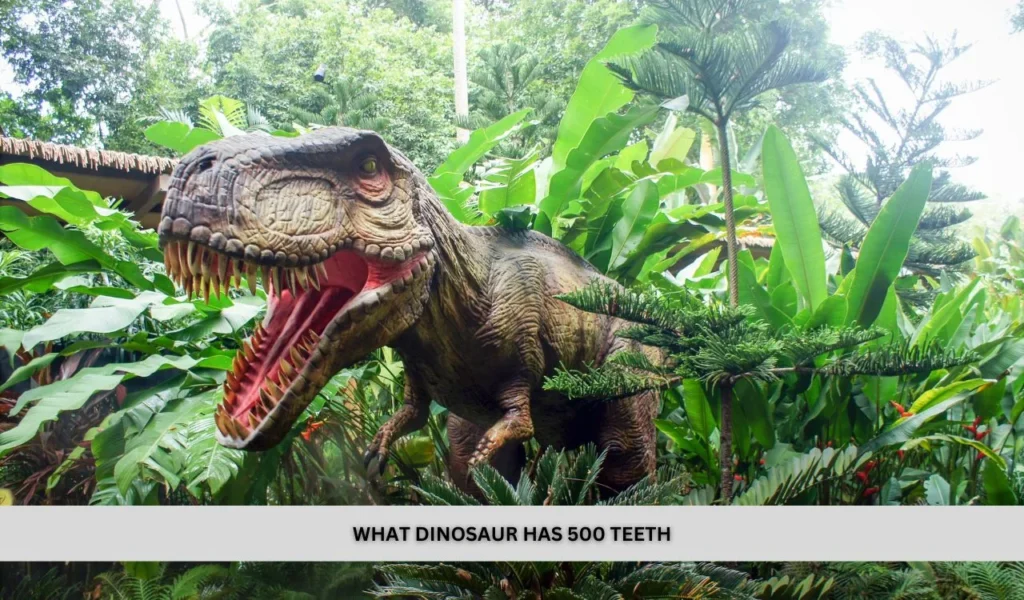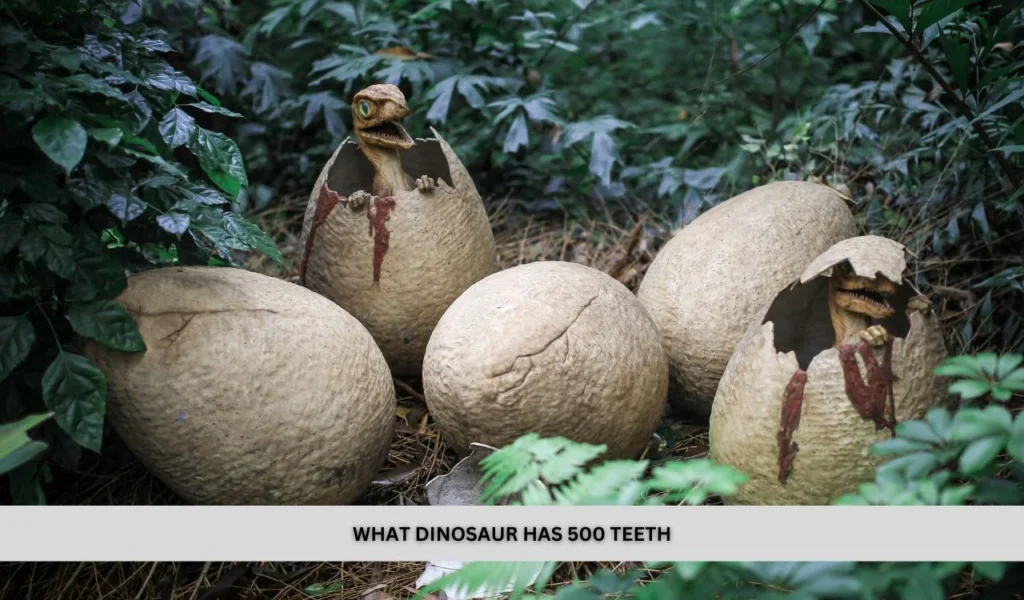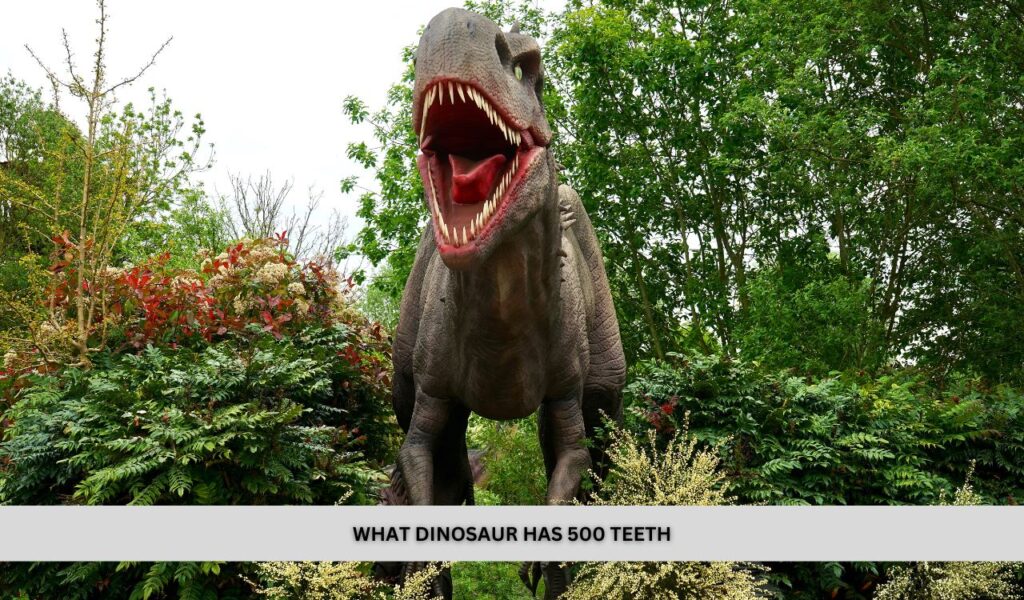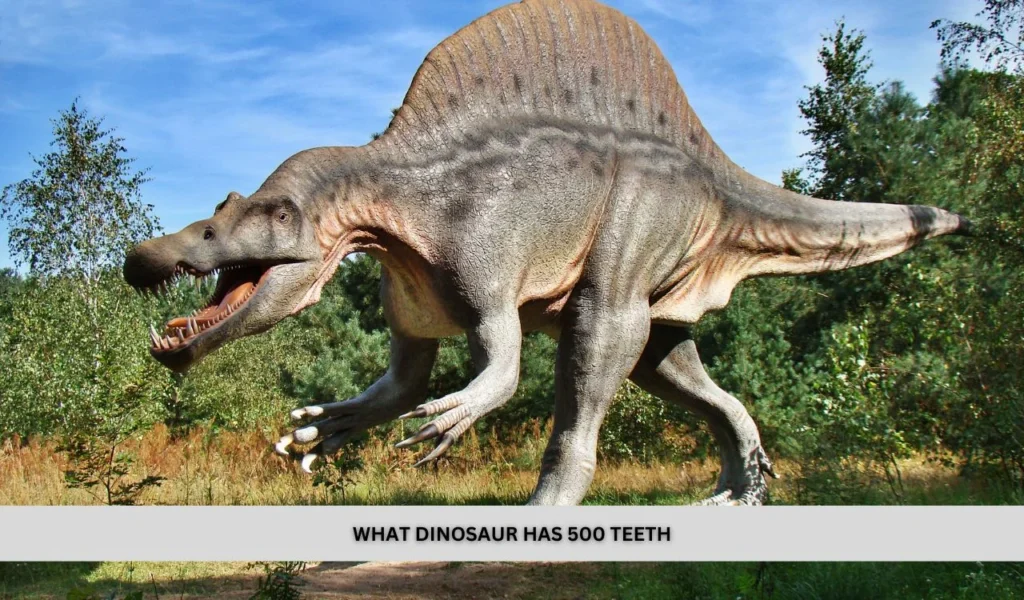What Dinosaur Has 500 Teeth

What Dinosaur Has 500 Teeth
Dinosaurs, the magnificent giants that once roamed the Earth, have long captivated our imagination with their diverse forms and unique adaptations. Among these prehistoric creatures, one stands out for its extraordinary dental structure: the Nigersaurus. This herbivorous dinosaur, which lived during the mid-Cretaceous period, is renowned for its jaw-dropping array of 500 teeth. In this article, we will explore the dental marvel that is the Nigersaurus, delving into the intricacies of its teeth, the evolutionary significance, and how this unique feature played a crucial role in its survival.
Overview of Dinosaur Dentition
Dinosaurs exhibited a remarkable variety of tooth structures, each adapted to their specific diets and ecological roles. From the razor-sharp teeth of carnivorous theropods to the flat, grinding teeth of herbivorous dinosaurs, these dental adaptations were key to their survival. The Nigersaurus, however, possessed a dental structure that was unlike any other, boasting a staggering 500 teeth perfectly designed for its herbivorous lifestyle.
Introduction to the Nigersaurus
The Nigersaurus is a fascinating dinosaur that inhabited what is now Niger, Africa, approximately 115 to 105 million years ago. Classified as a rebbachisaurid sauropod, this relatively small dinosaur (for a sauropod) measured around 30 feet in length and weighed up to four tons. Despite its modest size compared to other sauropods, the Nigersaurus had one of the most sophisticated dental systems among dinosaurs, which allowed it to efficiently process large amounts of plant material.
Read Also: PrimeWire: Free Streaming Platform
The Nigersaurus’ Dental Structure
Anatomical Details
The Nigersaurus’ teeth were arranged in rows along the edges of its wide, flat snout. Each side of its upper and lower jaws contained nine rows of teeth, and behind each active tooth, there were about 30 replacement teeth, ready to take over as the front teeth wore out. This arrangement meant that the Nigersaurus had 500 active teeth at any given time. The teeth were small, narrow, and closely packed, forming a continuous dental battery ideal for cropping vegetation close to the ground.
Comparative Analysis
When compared to other dinosaurs, the Nigersaurus’ dental structure stands out as particularly unique. Unlike the broad, flat teeth of the Hadrosaurus or the serrated teeth of theropods, the Nigersaurus’ teeth were specialized for a different kind of feeding. Its teeth were adapted for grazing low-lying vegetation, unlike other herbivores such as the Brachiosaurus, which used its long neck to reach high into the trees for food.
Functional Benefits
Feeding Efficiency
The Nigersaurus’ 500 teeth were not just for show; they were a highly efficient feeding tool. This dinosaur likely spent much of its time with its head close to the ground, sweeping its jaws from side to side to mow down ferns, horsetails, and other low-lying plants. The sheer number of teeth, combined with their rapid replacement, ensured that the Nigersaurus could continually feed without the need for long periods of rest to grow new teeth.
Survival Adaptations
This dental adaptation was crucial for the Nigersaurus’ survival in the rich, yet competitive, ecosystems of the mid-Cretaceous. The ability to quickly and efficiently process large amounts of vegetation gave the Nigersaurus a significant advantage, allowing it to sustain its large body and compete with other herbivores for resources.
Challenges and Limitations
Dental Maintenance
Maintaining 500 teeth must have posed its challenges. The Nigersaurus likely had a high rate of tooth wear due to the abrasive nature of the plants it consumed, which made its rapid tooth replacement system essential. However, this system also required a significant amount of energy and resources, which may have influenced other aspects of the dinosaur’s biology.
Evolutionary Perspective
The evolution of such a unique dental structure raises intriguing questions about the evolutionary pressures that shaped the Nigersaurus. The development of this extensive dental battery suggests that the Nigersaurus faced significant competition for food, driving the evolution of a feeding apparatus that maximized efficiency and minimized downtime for tooth replacement.
Read Also: SimpCity.su: Uncovering the Truth

What’s the Deal with All Those Teeth?
Evolutionary Development
The origins of such complex dental structures in dinosaurs are a testament to the diversity of evolutionary strategies in the Mesozoic era. The Nigersaurus’ teeth likely evolved as a response to the specific environmental conditions of its habitat, where low-lying vegetation was abundant, and competition for resources was fierce.
Adaptations Over Time
Over millions of years, dinosaurs like the Nigersaurus developed dental structures that were highly specialized for their diets. The evolution of these teeth reflects the constant pressure on species to adapt to their environments, ensuring their survival and proliferation.
Purpose and Function
Specialized Feeding Mechanisms
The Nigersaurus’ teeth were perfectly suited for grazing. The continuous replacement of teeth ensured that this dinosaur could maintain a full set of functional teeth throughout its life, allowing it to process large quantities of food efficiently. This specialization likely made the Nigersaurus one of the most successful herbivores in its ecosystem.
Dietary Preferences
The Nigersaurus primarily fed on low-lying vegetation, including ferns, cycads, and horsetails. Its teeth were adapted to shear through these plants, and its broad snout allowed it to gather large amounts of food with each sweep of its head.
Comparison with Other Herbivores
Herbivorous Dinosaurs
When we compare the Nigersaurus to other herbivorous dinosaurs, the differences in dental structures are striking. For example, the Hadrosaurus had hundreds of teeth, but they were arranged in dental batteries suited for grinding tough, fibrous plants. The Triceratops had beak-like jaws with shearing teeth, adapted for slicing through vegetation.
Functional Differences
These differences highlight the diversity of feeding strategies among herbivorous dinosaurs. While some relied on grinding tough plant material, the Nigersaurus specialized in cropping and processing soft, low-lying plants, a strategy that required a completely different dental structure.
How Did the Nigersaurus Use Its Teeth?
Feeding Mechanics
The Nigersaurus’ teeth were used in a highly specialized feeding mechanism. Its jaw was designed to move in a sweeping motion, much like a lawnmower, allowing it to efficiently crop vegetation close to the ground. The narrow, tightly packed teeth acted like a comb, shearing through plant material with each pass.
Grazing Behavior
The Nigersaurus likely spent much of its time grazing, moving slowly through its environment with its head close to the ground. This behavior was a direct result of its dental structure, which was perfectly adapted for processing the types of plants that grew in its habitat.
Read Also: Advicehindime.com: Unlocking the Power of Expert Advice

500 Teeth, But No Dental Floss?
Dental Maintenance
Despite the lack of dental hygiene tools like floss, the Nigersaurus had an effective natural system for maintaining its teeth. Its continuous tooth replacement ensured that worn or damaged teeth were quickly replaced, minimizing the impact of wear on its feeding efficiency.
Impact on Health
This continuous replacement likely had significant effects on the Nigersaurus’ health and longevity. While it ensured that the dinosaur always had a full set of functional teeth, the energy required for constant tooth production may have placed a significant burden on the dinosaur’s metabolism.
The Habitat and Environment of the Nigersaurus
Geological and Environmental Context
The Nigersaurus lived during the mid-Cretaceous period, a time when the Earth was warm, and lush vegetation covered much of the land. The region that is now Niger was a vast floodplain, rich in plant life, making it an ideal habitat for large herbivores like the Nigersaurus.
Climate and Vegetation
The climate during this period was warm and humid, with abundant rainfall that supported dense forests and vast expanses of low-lying vegetation. This environment provided the perfect conditions for the Nigersaurus to thrive, with plenty of food to support its large body and unique feeding habits.
How Did Nigersaurus’ Unique Dental Structure Aid Its Feeding Habits?
Feeding Efficiency
The Nigersaurus’ dental structure was a key factor in its feeding efficiency. Its ability to process large amounts of food quickly and effectively gave it a significant advantage in a competitive environment, allowing it to sustain its large body and outcompete other herbivores for resources.
Nutritional Benefits
The specialized dental structure of the Nigersaurus ensured that it could extract the maximum nutritional value from the plants it consumed. By efficiently processing large quantities of vegetation, the Nigersaurus was able to meet its nutritional needs and maintain its health in a challenging environment.
Read Also: CashStark.com: Unlocking Digital Success
The Top 10 Dinosaurs with The Most Teeth
Dinosaurs are often celebrated for their massive size, formidable claws, and fearsome jaws. However, their teeth—often overlooked—offer fascinating insights into their diets, behaviors, and evolutionary paths. Among the myriad of dinosaurs that once roamed the Earth, some species stood out for their incredibly high tooth counts. In this article, we’ll explore the top 10 dinosaurs with the most teeth, highlighting the unique adaptations and evolutionary significance of their dental structures.
1. Hadrosaurus: The Dinosaur with 1000 Teeth
Hadrosaurus tops the list as one of the dinosaurs with the most teeth. This herbivorous dinosaur, part of the Hadrosauridae family, had a dental structure designed for grinding tough, fibrous plants. The Hadrosaurus possessed a complex dental battery, with up to 1000 teeth arranged in rows. These teeth were continually replaced throughout the dinosaur’s life, ensuring it always had a fresh set of grinding tools to process its plant-based diet. The high tooth count allowed Hadrosaurus to efficiently break down vegetation, making it one of the most successful herbivores of its time.
2. Nigersaurus: The Dinosaur with 500 Teeth
The Nigersaurus is another dinosaur known for its remarkable dental structure, boasting 500 teeth. Unlike the Hadrosaurus, the Nigersaurus had narrow, closely packed teeth arranged in a unique dental battery along the edges of its broad, flat snout. This herbivore’s teeth were perfectly adapted for grazing low-lying vegetation. The rapid tooth replacement system ensured that the Nigersaurus could maintain its feeding efficiency despite the heavy wear on its teeth from continuous grazing.
3. Iguanodon: The Dinosaur with 30-40 Teeth Per Jaw
The Iguanodon, a well-known herbivorous dinosaur, had a relatively modest number of teeth compared to the Hadrosaurus and Nigersaurus. With 30-40 teeth per jaw, the Iguanodon’s teeth were specialized for shearing and slicing through tough vegetation. These teeth were broad and flat, with a unique arrangement that allowed the Iguanodon to effectively process the fibrous plants that made up its diet. Although it had fewer teeth than some other herbivores, the Iguanodon’s dental structure was highly efficient for its dietary needs.
4. Corythosaurus: The Dinosaur with 40-50 Teeth
The Corythosaurus, another member of the Hadrosauridae family, had a dental arrangement similar to that of the Hadrosaurus, with 40-50 teeth in each jaw. These teeth were designed for grinding and processing tough plant material, a necessity for this large herbivore. The Corythosaurus is also famous for its distinctive crest, but its dental structure was equally remarkable, allowing it to thrive in its lush, vegetative environment.
5. Hypsilophodon: The Dinosaur with Numerous Small Teeth
The Hypsilophodon was a small, fast-moving herbivore with a large number of small, closely packed teeth. While exact counts vary, this dinosaur is known to have had numerous teeth perfectly suited for its diet of soft vegetation. The Hypsilophodon’s teeth were designed for efficient grinding, allowing it to quickly process food as it foraged. Its dental structure was a key factor in its survival, enabling it to extract the necessary nutrients from its diet efficiently.
6. Saurolophus: The Dinosaur with a Unique Dental Structure
The Saurolophus, another hadrosaurid, had a unique dental structure featuring hundreds of teeth arranged in rows. These teeth were designed for grinding and processing tough plant material, similar to other members of its family. The Saurolophus also had a distinctive crest on its head, but it was its teeth that played a crucial role in its ability to thrive as a herbivore. The continuous replacement of teeth ensured that the Saurolophus could maintain its feeding efficiency throughout its life.
7. Brachiosaurus: The Dinosaur with Numerous Teeth for Browsing
The Brachiosaurus, one of the most iconic dinosaurs, had a dental structure that supported its browsing habits. Although it did not have as many teeth as some other herbivores, the Brachiosaurus had numerous large, spoon-shaped teeth designed for stripping leaves from tall trees. These teeth were well-adapted for processing the vast quantities of vegetation required to sustain its massive size. The Brachiosaurus’ teeth, combined with its long neck, allowed it to access food sources that were out of reach for other herbivores.
8. Pachycephalosaurus: The Dinosaur with Unique Dental Adaptations
The Pachycephalosaurus is best known for its thick, domed skull, but it also had a distinctive dental structure. While it did not have as many teeth as some other dinosaurs on this list, the Pachycephalosaurus possessed teeth that were well-adapted for its omnivorous diet, which likely included both plants and small animals. Its sharp, serrated teeth were ideal for cutting through tough plant material, making it a versatile feeder.
9. Triceratops: The Dinosaur with Multiple Rows of Teeth
The Triceratops, one of the most recognizable dinosaurs, had a powerful jaw equipped with multiple rows of teeth. These teeth were arranged in groups called dental batteries, with each battery containing dozens of teeth. As one tooth wore down, another would move into place, ensuring that the Triceratops always had a fresh set of teeth ready for grinding tough vegetation. This efficient system allowed the Triceratops to process large quantities of food, sustaining its massive body.
10. Stegosaurus: The Dinosaur with a Distinctive Dental Arrangement
Rounding out our list is the Stegosaurus, known for its distinctive plates and spikes, but it also had a unique dental arrangement. The Stegosaurus had relatively few teeth compared to other herbivores, but its teeth were large, flat, and suited for a diet of low-growing plants. The Stegosaurus’ teeth were designed for shearing through vegetation, allowing it to consume the tough, fibrous plants that made up its diet.
Comparative Analysis: Functional Comparisons
The diversity in tooth count and dental structures among these dinosaurs reflects the wide range of feeding strategies they employed. While some, like the Hadrosaurus and Nigersaurus, evolved high tooth counts to efficiently process large amounts of vegetation, others, like the Triceratops and Stegosaurus, developed unique dental adaptations suited to their specific diets. This variety highlights the evolutionary ingenuity of dinosaurs, enabling them to occupy a range of ecological niches and thrive for millions of years.
Evolutionary Insights: What Dental Structures Reveal
The study of dinosaur teeth provides valuable insights into the evolutionary history of these ancient creatures. The differences in dental structures not only reveal information about the diets and behaviors of individual species but also shed light on the environmental pressures that shaped their evolution. From the high tooth counts of Hadrosaurus and Nigersaurus to the specialized teeth of Stegosaurus and Triceratops, these adaptations demonstrate the incredible diversity and adaptability of dinosaurs in response to their changing environments.
Read Also: The Best Solutions for Video Editing in 2024

Conclusion
The study of dinosaur teeth offers a fascinating glimpse into the lives of these ancient creatures, revealing how their dental adaptations played a crucial role in their survival and evolutionary success. From the 1000 teeth of Hadrosaurus to the 500 teeth of Nigersaurus, these dinosaurs developed complex dental structures that allowed them to efficiently process their food and thrive in their respective environments. The variety in tooth count and dental designs among these top ten dinosaurs underscores the incredible adaptability of these species, each tailored to their unique ecological niches.
Understanding the diversity of dinosaur teeth not only enhances our knowledge of their diets and behaviors but also provides broader insights into the evolutionary pressures that shaped these magnificent creatures. As we continue to unearth new fossils and study these ancient giants, their teeth remain a key to unlocking the mysteries of their past.





